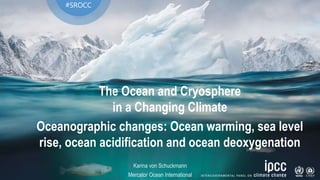
Oceanographic Changes
- 1. The Ocean and Cryosphere in a Changing Climate Oceanographic changes: Ocean warming, sea level rise, ocean acidification and ocean deoxygenation #SROCC Karina von Schuckmann Mercator Ocean International
- 3. Meters 1950 2000 2050 2100 1021Joules Ocean warming High greenhouse gas emission scenario in the absence of policies to combat climate change (RCP8.5). 2081-2100 temperature = +4.3oC (±1.1oC) 2081-2100 CO2 concentration = 850 ppm Low greenhouse gas emission scenario, with high mitigation (RCP2.6). Gives a 2 in 3 chance of limiting warming to below 2oC by 2100. 2081-2100 temperature = +1.6oC (±0.7oC) 2081-2100 CO2 concentration = 426 ppm Due to emissions of heat-trapping gases resulting from human activities, the global ocean has warmed as it has taken up more than 90% of the excess heat in the climate system, making climate change irreversible.
- 4. Meters 1950 2000 2050 2100 1021Joules Ocean warming • Ocean warming is continuing unabated. Since the last three decades, the rate of ocean warming has increased and around half of the total heat gain in the global ocean has occurred in the Southern Ocean in the last decade. • The ocean will continue to warm throughout the 21st century. By 2100, the ocean will take up 2 to 4 times more heat if global warming is limited to 2°C and up to 5 to 7 times at higher emissions.
- 5. Primary drivers Sea level rise 1950 2000 2050 2100 0.3 0.2 Antarctic ice sheet mass loss 2150 2200 2250 2300 Greenland ice sheet mass loss Glacier mass loss 0.1 0 0.3 0.2 0.1 0 0.3 0.2 0.1 0 Ocean heat content (0−2000 m depth) as 1021 Joules (right axis) Metres Metres Metres 2400 1600 800 0 1950 2000 2050 2100 0.84 m 0.43 m Global mean sea level Metres 5 4 3 2 1 0 Values as sea level equivalent Changes relative to 1986–2005 Historical (observed) Historical (modelled) Projected (RCP2.6) Projected (RCP8.5)
- 6. Sea level rise • During the 20th century, the global mean sea level rose by about 15cm. Sea level is currently rising more than twice as fast. • Sea level rise will further accelerate reaching up to 1.10 m in 2100 if emissions are not sharply reduced. • There is no scenario that stops sea level rise this century. We have the choice between below 1 metre and up to several metres of sea level rise by 2300
- 7. The increase in anthropogenic CO2 occurs throughout the upper 1000 m, with different penetration depths, reflecting largely differences in the efficiency, with which the anthropogenic CO2 is transported from the surface to depth Ocean uptake of anthropogenic CO2 between 1994 and 2007 Ocean acidification The ocean has taken up 20-30% of the global emissions from human activities over the past 3 decades.
- 8. • As a consequence of anthropogenic carbon uptake, the ocean has undergone increasing surface acidification. • Continued carbon uptake by the ocean by 2100 is virtually certain to exacerbate ocean acidification. Ocean acidification Surface pH 1950 2000 2050 2100 8.1 8.0 7.9 pH 7.8 Historical (observed) Historical (modelled) Projected (RCP2.6) Projected (RCP8.5)
- 9. Absolute change in dissolved oxygen over the period 1960-2010 Ocean oxygen 2 0 –2 –6 % –4 Ocean deoxygenation • Surface ocean warming is making the surface ocean less dense relative to deeper parts of the ocean and inhibiting mixing and exchange of heat, carbon, nutrients and oxygen. • A loss of oxygen has occurred from the surface to 1000 m • Ocean oxygen is projected to further decline over the 21st century.
- 10. Our changing ocean The ocean is transitioning to new states, unprecedented since the pre-industrial.
- 11. SROCC
Editor's Notes
- Metres SLR by 2300 due to: Thermal expansion Glacier melt Ice sheet melt
- Metres SLR by 2300 due to: Thermal expansion Glacier melt Ice sheet melt
- What we see is that human-induced climate change has a major footprint on the systems that we depend upon – from the top of the mountains to the depth of oceans. These changes will continue for generations to come.